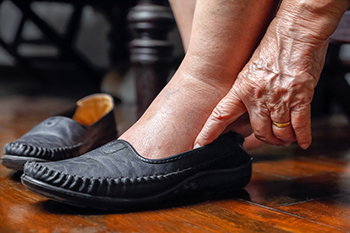Connect With Us
Blog
Items filtered by date: March 2025
Let the Expert Treat Your Ingrown Toenails
Causes and Symptoms of Pinky Toe Pain

Pinky toe pain can result from various conditions affecting the skin, nerves, and joints. Corns, caused by friction or pressure from tight shoes, create painful, hardened areas on the toe. Footwear that squeezes the toes or lacks support can lead to discomfort and misalignment. Nerve issues, such as pinched nerves or neuropathy, may cause tingling, burning, or sharp pain. Overuse from repetitive movements or excessive walking can strain the toe, leading to soreness and inflammation. Additionally, arthritis, particularly in older adults, can cause stiffness, swelling, and persistent pain in the small joints of the toe. If you have pain in your pinky toe, it is suggested that you consult a podiatrist who can offer effective relief and treatment solutions.
Toe pain can disrupt your daily activities. If you have any concerns, contact David Cain, DPM of Iowa. Our doctor can provide the care you need to keep you pain-free and on your feet.
What Causes Toe Pain?
Most severe toe pain is caused due to a sports injury, trauma from dropping something heavy on the toe, or bumping into something rigid. Other problems can develop over time for various reasons.
Toe pain can be caused by one or more ailments. The most common include:
- Trauma
- Sports injury
- Wearing shoes that are too tight
- Arthritis
- Gout
- Corns and calluses
- Hammertoe
- Bunions
- Blisters
- Ingrown toenails
- Sprains
- Fractures (broken bones)
- Dislocations
When to See a Podiatrist
- Severe pain
- Persistent pain that lasts more than a week
- Signs of infection
- Continued swelling
- Pain that prevents walking
Diagnosis
In many cases the cause of toe pain is obvious, but in others, a podiatrist may want to use more advanced methods to determine the problem. These can range from simple visual inspections and sensation tests to X-rays and MRI scans. Prior medical history, family medical history, and any recent physical traumatic events will all be taken into consideration for a proper diagnosis.
Treatment
Treatments for toe pain and injuries vary and may include shoe inserts, padding, taping, medicines, injections, and in some cases, surgery. If you believe that you have broken a toe, please see a podiatrist as soon as possible.
If you have any questions please feel free to contact our office located in Ames, Iowa . We offer the newest diagnostic tools and technology to treat your foot and ankle needs.
Link Between Swollen Feet and Diabetes

Swollen feet and ankles are a common issue for diabetic patients due to circulation problems and fluid buildup. High blood sugar can weaken blood vessels to the lower limbs and feet. This may result in poor circulation and venous insufficiency, allowing fluid to collect in the feet and ankles. Some people who have diabetes are at higher risk for blood clots, which may cause swelling in one leg and require immediate medical attention. Certain medications used to manage diabetes also can also cause fluid retention, which increases the likelihood of swelling. Left untreated, persistent swelling of the feet and ankles may lead to infections or ulcers that can be difficult to heal. A podiatrist can evaluate the cause of swelling, check for underlying complications, and recommend treatment, including medical management, specialized footwear, or surgery when necessary. If you have swollen feet that may be linked to diabetes, it is suggested that you make a podiatrist a part of your medical management team.
Diabetic foot care is important in preventing foot ailments such as ulcers. If you are suffering from diabetes or have any other concerns about your feet, contact David Cain, DPM from Iowa. Our doctor can provide the care you need to keep you pain-free and on your feet.
Diabetic Foot Care
Diabetes affects millions of people every year. The condition can damage blood vessels in many parts of the body, especially the feet. Because of this, taking care of your feet is essential if you have diabetes, and having a podiatrist help monitor your foot health is highly recommended.
The Importance of Caring for Your Feet
- Routinely inspect your feet for bruises or sores.
- Wear socks that fit your feet comfortably.
- Wear comfortable shoes that provide adequate support.
Patients with diabetes should have their doctor monitor their blood levels, as blood sugar levels play such a huge role in diabetic care. Monitoring these levels on a regular basis is highly advised.
It is always best to inform your healthcare professional of any concerns you may have regarding your feet, especially for diabetic patients. Early treatment and routine foot examinations are keys to maintaining proper health, especially because severe complications can arise if proper treatment is not applied.
If you have any questions please feel free to contact our office located in Ames, Iowa . We offer the newest diagnostic and treatment technologies for all your foot and ankle needs.
Understanding Venous Ulcers and Their Impact on Lower Limbs

Venous ulcers are slow-healing wounds caused by poor circulation in the veins, typically in the lower legs and ankles. They develop when blood pools due to faulty valves, leading to increased pressure and skin breakdown. These ulcers often appear as shallow, irregular sores with discoloration, swelling, and discomfort. Individuals at higher risk include those with varicose veins, deep vein thrombosis, DVT, obesity, or a history of leg injuries. People who stand or sit for prolonged periods may also develop these chronic wounds. Venous ulcers directly affect the feet and ankles by causing swelling, skin changes, and persistent wounds prone to infection. Without proper care, complications may arise. Compression therapy, wound management, and lifestyle changes help improve healing. If you have venous ulcers, it is strongly suggested that you include a podiatrist on your healthcare team for effective treatment and prevention.
Wound care is an important part in dealing with diabetes. If you have diabetes and a foot wound or would like more information about wound care for diabetics, consult with David Cain, DPM from Iowa. Our doctor will assess your condition and provide you with quality foot and ankle treatment.
What Is Wound Care?
Wound care is the practice of taking proper care of a wound. This can range from the smallest to the largest of wounds. While everyone can benefit from proper wound care, it is much more important for diabetics. Diabetics often suffer from poor blood circulation which causes wounds to heal much slower than they would in a non-diabetic.
What Is the Importance of Wound Care?
While it may not seem apparent with small ulcers on the foot, for diabetics, any size ulcer can become infected. Diabetics often also suffer from neuropathy, or nerve loss. This means they might not even feel when they have an ulcer on their foot. If the wound becomes severely infected, amputation may be necessary. Therefore, it is of the upmost importance to properly care for any and all foot wounds.
How to Care for Wounds
The best way to care for foot wounds is to prevent them. For diabetics, this means daily inspections of the feet for any signs of abnormalities or ulcers. It is also recommended to see a podiatrist several times a year for a foot inspection. If you do have an ulcer, run the wound under water to clear dirt from the wound; then apply antibiotic ointment to the wound and cover with a bandage. Bandages should be changed daily and keeping pressure off the wound is smart. It is advised to see a podiatrist, who can keep an eye on it.
If you have any questions, please feel free to contact our office located in Ames, Iowa . We offer the newest diagnostic and treatment technologies for all your foot care needs.
Causes of Ankle Pain While Playing Pickleball

Ankle pain during pickleball is a common complaint due to the intense movements involved in the sport. One of the leading causes is overuse, as frequent lateral movements, quick starts, and sudden stops place stress on the ankle joint. Another cause is improper footwear, which may not provide the necessary support or cushioning for the specific demands of pickleball. Ankle sprains, where the ligaments are stretched or torn, can also occur from twisting or rolling the ankle while trying to return a fast ball or change direction quickly. Poor technique or lack of warm-up exercises can contribute to muscle strains and joint stiffness, further increasing the risk of injury. Players with previous ankle injuries may experience recurring pain as well. If you enjoy playing pickleball and have endured an ankle injury, it is suggested that you consult a podiatrist who can offer effective treatment so you can return to this popular sport.
Ankle pain can have many different causes and the pain may potentially be serious. If you have ankle pain, consult with David Cain, DPM from Iowa. Our doctor will assess your condition and provide you with quality foot and ankle treatment.
Ankle pain is any condition that causes pain in the ankle. Due to the fact that the ankle consists of tendons, muscles, bones, and ligaments, ankle pain can come from a number of different conditions.
Causes
The most common causes of ankle pain include:
- Types of arthritis (rheumatoid, osteoarthritis, and gout)
- Ankle sprains
- Broken ankles
- Achilles tendinitis
- Achilles tendon rupture
- Stress fractures
- Tarsal tunnel syndrome
- Plantar fasciitis
Symptoms
Symptoms of ankle injury vary based upon the condition. Pain may include general pain and discomfort, swelling, aching, redness, bruising, burning or stabbing sensations, and/or loss of sensation.
Diagnosis
Due to the wide variety of potential causes of ankle pain, podiatrists will utilize a number of different methods to properly diagnose ankle pain. This can include asking for personal and family medical histories and of any recent injuries. Further diagnosis may include sensation tests, a physical examination, and potentially x-rays or other imaging tests.
Treatment
Just as the range of causes varies widely, so do treatments. Some more common treatments are rest, ice packs, keeping pressure off the foot, orthotics and braces, medication for inflammation and pain, and surgery.
If you have any questions, please feel free to contact our office located in Ames, Iowa . We offer the newest diagnostic and treatment technologies for all your foot care needs.

